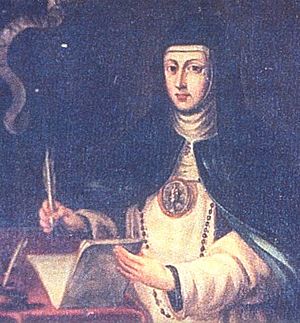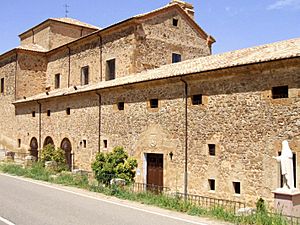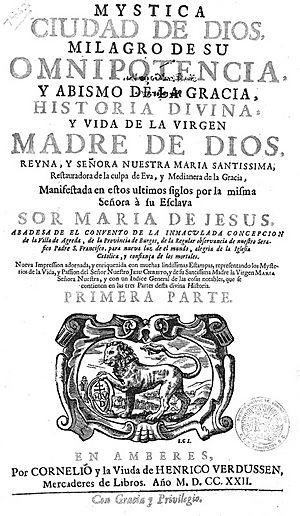Mary of Jesus of Ágreda facts for kids
Quick facts for kids VenerableMary of Jesus of Ágreda OIC |
|
|---|---|
 |
|
| Virgin | |
| Born | 2 April 1602 Ágreda, Soria, Spain |
| Died | 24 May 1665 (aged 63) Ágreda, Soria, Spain |
Mary of Jesus of Ágreda (in Spanish: María de Jesús de Ágreda), also known as the Abbess of Ágreda, was a Spanish nun and writer. She lived from 1602 to 1665. She is famous for her many letters with King Philip IV of Spain. She also reported having special experiences called bilocation. This means she felt like she was in two places at once. People called her the Lady in Blue or the Blue Nun. This was because of the blue color of her religious clothes.
Mary of Jesus was a member of the Order of the Immaculate Conception. She wrote 14 books. One important book was about the life of the Blessed Virgin Mary. Her bilocation experiences were said to happen between her monastery in Spain and the Jumano Indians in what is now New Mexico and Texas. These stories inspired many missionaries.
Contents
Life of Mary of Jesus
Early Years
Mary of Jesus was born María Coronel y de Arana in Ágreda, Spain. Her parents were Francisco Coronel and Catalina de Arana. They had 11 children, but only four lived to be adults. The family was close to the Franciscan friars nearby.
Even as a young girl, Mary had special visions. She felt that God was teaching her about the world. When she was four, a bishop named Diego de Yepes confirmed her. He was impressed by her spiritual understanding.
When Mary was 12, she decided to become a nun. She wanted to join a monastery in Tarazona. But her mother had a vision. She felt that their family home should become a monastery instead. Both she and her daughters would become nuns there. Mary liked this idea. Her father did not agree at first. After three years, in 1618, he became a lay brother in a Franciscan friary. Her brothers were already friars. In January 1619, Mary and her mother entered the new convent together.
Becoming a Nun
Catalina and her daughters turned their home into the Monastery of the Immaculate Conception. This monastery belonged to the Order of the Immaculate Conception. This order was very important in Spain at that time.
Mary was 16 when she and her mother and sister took their religious vows. She was given the name Mary of Jesus. Other women joined the community. The monastery was rebuilt and finished in 1633. In 1620, Mary made her final vows. She then experienced a period of illness. After her mother died, Mary was chosen as the abbess (leader) of the monastery. She was only 25 years old. She remained in charge until her death, except for a short break.
Mary of Jesus often practiced "internal prayer." Like Teresa of Avila, she had religious ecstasies. These included reports of her body floating, which is called levitation.
Her Writings
Mary of Jesus' most famous work is the Mystical City of God. This book has eight parts. She said these were revelations she received directly from the Blessed Virgin Mary. The books talk about Mary's life on Earth and in heaven. They also describe her relationship with God and the actions of Jesus. The book gives advice on how to live a holy life.
The Mystical City of God is studied today in colleges. It is important for its contribution to Spanish literature. It describes both earthly and spiritual details. For example, it included how the Earth looks from space. It also gave details about the Immaculate Conception of Mary and the childhood of Jesus.
Besides her 14 published works, Mary of Jesus also advised King Philip IV of Spain. She was his spiritual and sometimes political advisor for over 22 years. More than 600 of their letters still exist today.
The "Lady in Blue"
Between 1620 and 1623, Mary of Jesus said that angels often took her to places where the Jumano people lived. The Jumano Indians in New Spain (today's Texas and New Mexico) had been asking for missionaries. They hoped for protection from other tribes. A mission led by Franciscan Friar Juan de Salas visited them in 1629.
Mary reported more visits later, but less often. She always stayed in her monastery in Spain. These events are called bilocation. This is when a person seems to be in two places at the same time.
Before sending the friars, Father Alonzo de Benavides asked the natives why they wanted to be baptized. They said a Lady in Blue had visited them. She told them to ask the fathers for help. They pointed to a painting of a nun in a blue habit. They said the Lady was dressed like that but was a beautiful young girl. The Jumanos said the Lady in Blue visited them near what is now Salinas National Monument in New Mexico.
At the same time, a friar brought Benavides a question from Mary's confessor in Spain. He asked if there was any proof that she had visited the Jumanos. Stories of Mary's visits to the New World spread. These stories, and her book, inspired missionaries in the 17th and 18th centuries. They saw her as an important part of the history of the United States.
Death and Legacy
Less than ten years after she died, Pope Clement X declared Mary of Jesus "Venerable." This honored her very virtuous life. The process to declare her a saint began in 1673, but it is not yet finished.
Mary of Jesus's book, The Mystical City of God, describes an apparition of the Virgin Mary to Saint James. This vision is linked to the shrine of El Pilar. This shrine is believed to be the first church dedicated to Mary. This story helped inspire the rebuilding of the Cathedral Basilica in Zaragoza, Spain, in 1681.
Incorruptible Body
When Mary of Jesus's coffin was opened in 1909, her body was examined. In 1989, a Spanish doctor named Andreas Medina examined her remains again. He said that the body had not changed at all in 80 years. It showed no signs of normal decay. Investigators took photos and then sealed her coffin again. It is still on display in the monastery church. Some people believe that a body not decaying after death is a sign of holiness.
Sainthood Process
Mary of Jesus is considered "Venerable." After the 400th anniversary of her birth in 2002, several groups renewed efforts to move her beatification process forward.
See also
 In Spanish: María de Jesús de Ágreda para niños
In Spanish: María de Jesús de Ágreda para niños




